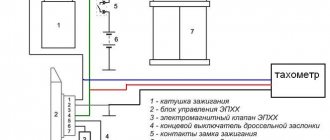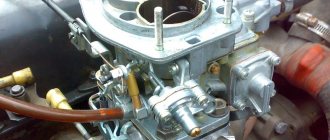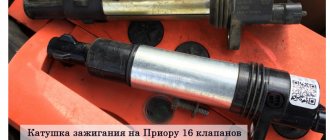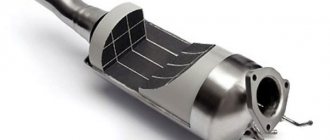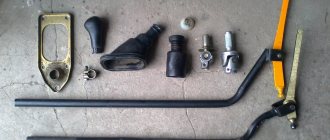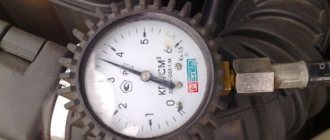How does the intake manifold length change system work?
An intake manifold with a variable length system is used in both gasoline and diesel engines to ensure better filling of the combustion chamber with air at different engine speeds.
At low speeds, maximum torque is required to be achieved as quickly as possible, which is achieved by using a long intake manifold. High revs bring the engine to maximum power with a short intake manifold.
This system works the same on most cars. An axis with flaps is installed in the intake manifold, which block or open the path to air flow along one of two paths - short or long.
The system for changing the length of the intake manifold usually consists of the following elements:
- receiver with check valve
- solenoid valve
- mechanism for changing length (pneumatic chamber)
- axle with flaps
- connecting vacuum tubes
- wiring to the solenoid valve
Let's look at the design and operation of the system in more detail using the example of a Chevrolet Lacetti.
In the photo below I noted:
- red arrow – receiver with check valve
- green arrow – solenoid valve
- blue arrow – wiring to the solenoid valve
- yellow arrow – mechanism (pneumatic chamber) for changing length
- numbers - connecting vacuum tubes: 1 - from the solenoid valve to the mechanism (pneumatic chamber), 2 - from the manifold to the receiver, 3 - from the receiver to the valve.
With the engine turned off, the rod of the mechanism (pneumatic chamber) is fully extended and the system is in the state of a short manifold. As soon as we start the engine, a vacuum is created in the manifold and the pressure drops to 30-33 kPa. Voltage is applied to the valve and it opens, thereby releasing vacuum from the manifold through the receiver into the working mechanism (pneumatic chamber). The pneumatic chamber retracts its rod and, turning the valve axis, transfers the system to a long manifold, which ensures throttle response at low engine speeds. The system will remain in this position until the engine reaches a speed of 4.5 thousand rpm. After this, the ECU turns off the voltage supply to the valve and it closes, cutting off the vacuum supply to the pneumatic chamber. The pneumatic chamber rod should now fully extend and rotate the damper axis again into short manifold mode. But how will it come out if the pneumatic chamber is sealed and it needs air access so that the spring in the pneumatic chamber can move the rod? It's like putting a bottle in water upside down. Water will not get into it until you make a hole in the bottom to let the air out.
For these purposes, the solenoid valve also has a third fitting, which is closed by a cap (filter), which is located at the bottom and the green arrow points to it. This is an atmospheric fitting. When the voltage is turned off, the solenoid valve not only blocks the vacuum from the receiver to the pneumatic chamber, but also opens the transition from the pneumatic chamber to the atmospheric fitting, allowing the pneumatic chamber to draw in air and extend the rod.
Now let's briefly look at the device and check each node separately.
We remove the manifold ourselves
Initially, any car enthusiast, in order to begin replacing or repairing this part, needs to know how to dismantle the intake manifold. In general, this procedure is not complicated and can be completed by one person in ten minutes. First you need to find the fuel pump and remove the fuse from it, after which you need to start the engine. The pressure in the system will drop significantly, and in the near future the engine will stall.
After the procedure, you can disconnect the battery and remove the decorative casing from the motor itself. After this, it is necessary to remove the pipes from the air filter and remove it. Afterwards, you should unscrew the throttle assembly. It is important to note that you should not touch the damper fasteners to avoid damaging them. That's it, the collector is before my eyes.
In some cases, the square tubes peel off. Then you will need to drill two holes in the collector itself so that through these holes you can get to this tube. After this, you need to screw the screws into these holes and secure it. The control valve and dampers cannot be replaced or repaired separately. This is why you should buy and install a completely new part. If the cause of the breakdown is the sensor, then the element that has failed needs to be replaced.
Intake manifold length control solenoid valve
The valve consists of a body, a locking mechanism, three fittings and an electromagnetic coil. To remove the valve from the car, just bend the latch on the receiver side and slide the valve down
The valve has three fittings. One of them (atmospheric) is closed with a lid. It must be removed to check and remove dirt.
To check the valve's closing properties, simply blow into the side fitting. In this case, the air should go out into the lower (atmospheric) fitting, but not into the upper one. If you apply voltage to the valve, then everything should be the other way around.
To check the valve winding, just press the clamp of the wire block and remove it
There will be two contacts visible on the valve. You need to connect an ohmmeter to them and measure the resistance, which should be several ohms. If the resistance is normal and the valve does not work, then you need to check the incoming voltage at the block, which should be about 12 V. Don't forget to start the engine to measure the voltage.
How does the manifold affect engine performance?
When the engine operates at maximum speed with the gas pedal fully depressed, the speed of air in the manifold approaches (and in sports cars noticeably exceeds) the speed of sound. At such speeds, any turn and the slightest bump turn out to be a serious obstacle, which greatly increases the resistance of the collector to air flow. As a result, less air enters the cylinders, so engine power drops. In this mode, the carburetor often produces an over-lean mixture, the burning rate of which is tens of times faster than normal. Therefore, the air-fuel mixture explodes, which leads to damage to valves, pistons and other engine elements.
Equally important is a high-quality connection between the manifold and the carburetor or air filter. If the sealing elements are worn out or the fastening nuts are poorly tightened, then air leaks occur at the contact point, resulting in an over-lean mixture and explosions in the combustion chamber.
Receiver (vacuum tank) of the system for changing the length of the intake manifold
This is a cylindrical container with a check valve inside. The check is very simple and consists of two points:
- check integrity to ensure there is no vacuum leak
- disconnect the tube going to the solenoid valve, and disconnect the second tube from the manifold (tube No. 2). Blow into this tube - no air should pass through. But when sucked into itself, the air must pass through!
Working mechanism (pneumatic chamber) of the system for changing the length of the intake manifold
This is the weakest link in this chain.
The pneumatic chamber consists of a body (metal or plastic), a rod, a diaphragm and a spring.
Most often, the system for changing the geometry of the intake manifold fails precisely because of a worn-out pneumatic chamber diaphragm. It can be called a consumable item.
To check the integrity of the spring and diaphragm, simply disconnect the vacuum tube and press in the rod. The rod should enter without jamming, and when released, it should move out sharply. This means the spring is intact and the damper axis does not jam.
Now press the rod in and close the fitting with your finger. The rod should not come out of the pneumatic chamber completely. If it comes out, it means the diaphragm is torn.
Here is a video of the working mechanism with a slightly worn diaphragm. Look closely
The diaphragm still works somehow. The rod retracts at idle, but as soon as you press the gas pedal a little, the rod comes out a little. This happens because when the throttle valve opens, the pressure in the manifold increases and the vacuum decreases. And this vacuum is no longer enough to hold the torn diaphragm. Although it would hold an entire diaphragm without problems.
Upon reaching a speed of 4.5 thousand rpm, the rod extends completely, as it should be. This means that the entire system is working properly, except for the diaphragm.
But the main problem is not even that the collector is now incorrectly converted to long/short. Or rather, this is also a big problem, but there is an even more serious one.
The fact is that up to 4.5 thousand rpm the solenoid valve is open and, naturally, releases a vacuum into the pneumatic chamber with a torn diaphragm, which leads to the suction of unaccounted air into the intake manifold! Because of this, the correct operation of the engine at low and medium speeds is disrupted. There are dips, jerking, an increase in idle speed and, accordingly, fuel consumption hits your pocket even more.
Therefore, the pneumatic chamber must be replaced.
If you notice that the diaphragm is damaged, and the house is still very far away and there is no opportunity to buy a new pneumatic chamber, then you can do the following:
- Disconnect the vacuum tube from the manifold and plug the fitting on the manifold. Attention!!! You just need to look for a plug that fits ON the fitting (for example, bend the hose and secure it with wire, the rubber part from a medical pipette, etc.), and NOT into the fitting (matches, toothpicks, etc.). This is exactly what is needed to prevent your plug from being sucked into the manifold! I used a piece of vacuum hose that was bent and crimped with wire.
- Recess the pneumatic chamber rod and secure it in this position with wire, a clamp or something similar.
So you can calmly drive wherever your eyes look. But remember that at high engine speeds the dynamics will be slightly worse.
Why might you need to repair the intake manifold?
At its core, the intake manifold has a rather complex design. Based on these considerations, the likelihood of breakdown or malfunction of a certain individual element of the entire device increases significantly. Dampers often fail (mainly on German car brands).
In this case, the car becomes very weak and significantly loses power. At the same time, fuel consumption increases significantly, and traction and engine performance generally deteriorate. Manifold flaps fail for several reasons: low-quality material used to make these flaps, too high a temperature, and the presence of oil condensate.
In addition, the control valve for these intake manifold flaps may also fail. A sign that oil consistency has entered the intake manifold is its increased consumption, which can exceed 1 liter per 1 thousand km.
In parts that are made of plastic, you can often encounter a problem that involves disconnecting the tube from the swirler. This, in turn, gives rise to a certain characteristic sound during actual movement: noise and crackling in the car. This breakdown can be completely solved even with your own hands.
We recommend: The principle of operation of the electric window and the causes of failure
In addition, air leaks may occur in the intake manifold itself. This breakdown may affect the vehicle's power. But the most important thing is that there will be a serious noise that resembles suction or blowing.
In automotive nature, there is a special sensor that is used to measure the absolute pressure in the intake manifold. This sensor, in addition to the above function, is responsible for optimizing combustion processes and the formation of a mixture of air and fuel. If this sensor fails, then most likely the electronic control unit will begin operating in emergency mode.
Sometimes it happens that the engine cannot be started at all. The design of the modern sensor, located in the intake manifold, is quite reliable. And yet, malfunctions in it are possible.

